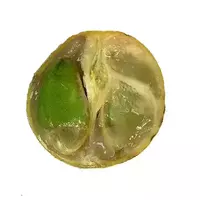Vampies

Wampi or Clausena lansium belongs to fruit trees from the Rutov family. Evergreen refers to a species of plant called Clausena dotted. As a rule, the wampi tree does not exceed 6 meters in height. The wampi is a fruit tree with flexible branches and a gray-brown bark with large enough leaves with a feathery shape.
The fruits of the wampi fruit plant look like clusters. The fruit fruits of the vampire resemble plums in shape and size and are distinguished by a yellow-brown shell, which is quite easily separated from the pulp. Researchers are confident that the vampire plant comes from Indochina, or rather the territories of South China. Wampi are currently grown in the Hawaiian Islands, Philippines, India, Indonesia, Australia, Sri Lanka, Australia and Malaysia.
Notably, wampi refers to distant relatives of citrus orange fruit. Clusters of vampire fruits are similar to grapes and sometimes include up to 80 fruits, each of which contains five segments of aromatic pulp with exotic taste and seed. It is noteworthy that the wampi tree, although it grows mainly in tropical and subtropical climates, perfectly senses itself in the greenhouse conditions of foggy Albion. The English have long grown the plant in greenhouses.
They eat vampire fruits, which have many folk names. For example, in Malaysia, vampis are called "wang-pei, " in the Philippine islands - "shalumpi. " Wampi fruit is very popular in Vietnam, where it is called "hong bi, " as well as in Thailand, where it is known not otherwise as "som-ma-fai. " It is worth noting that vampire fruits are not only eaten, but also used as a medicine in folk medicine.
For example, in Vietnam and China, immature and sun-dried vampire fruits are used in the treatment of cough or bronchitis. In Thailand, dried wampi fruits are used in the production of canned fruit assortments. When ripe, the vampire fruits take on a brightly orange color. The vampi peel has a resinous and bitter taste, so it is better to peel the fruit before eating. As a rule, one wampi fruit contains several seeds.
However, recently, more and more varieties of plants have been used in writing, the fruits of which, thanks to the work of breeders, do not contain more seeds. In China, wampi fruits are served as seasoning for meat dishes. Often, vampire fruits become the filling of national Chinese pastries. In addition, low-alcohol tinctures and aperitifs are made from vampire fruits in the likeness of sparkling champagne wines.
wampi 0.1 kCal
Energy value of wampi (Ratio of proteins, fats, carbohydrates - ju):
Proteins: 0 g (~ 0 kCal)
Fats: 0 g (~ 0 kCal)
Carbohydrates: 0 g (~ 0 kCal)
Energy ratio (b | y): 0% | 0% | 0%
 Español
Español Français
Français Português
Português Русский
Русский 简体中文
简体中文 繁體中文
繁體中文 日本語
日本語 한국어
한국어 العربية
العربية Türkçe
Türkçe Қазақ
Қазақ Deutsch
Deutsch Italiano
Italiano Українська
Українська
